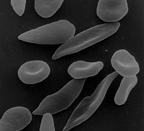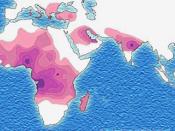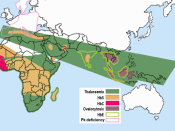Sickle Cell anemia is a group of inherited red blood cell disorders, or a collection of recessive genetic disorders characterized by a hemoglobin variant called Hb S. Normal red blood cells are round like doughnuts, and they move through small blood tubes in the body to deliver oxygen. Sickle red blood cells become hard, sticky and shaped like sickles used to cut wheat. When these hard and pointed red cells go through the small blood tube, they clog the flow and break apart. This can cause pain, damage and a low blood count, or anemia. There is a substance in the red cell called hemoglobin that carries oxygen inside the cell. One little change in this substance causes the hemoglobin to form long hard rods in the red cell when it gives away oxygen. These rigid rods change the red cell into a sickle shape.
For such a miniscule mistake, the consequences are tragic.
At the time of conception, a person receives one set of genes from the mother and a corresponding set of genes from the father. Sickle cell disease is a condition that is determined by a single pair of genes. The genes are those which control the production of hemoglobin in red cells. It is a member of the globin gene family, a group of genes involved in oxygen transport, and hemoglobin binds oxygen in the lungs and delivers it to the other tissues. Most people have two normal genes for hemoglobin. Some people carry one normal gene and one gene for sickle hemoglobin. This is called "sickle cell trait".
These people are normal in almost all respects. Problems from having a single sickle cell gene develop only under very unusual conditions. People who inherit two genes for sickle hemoglobin (one from each parent) have sickle cell...


